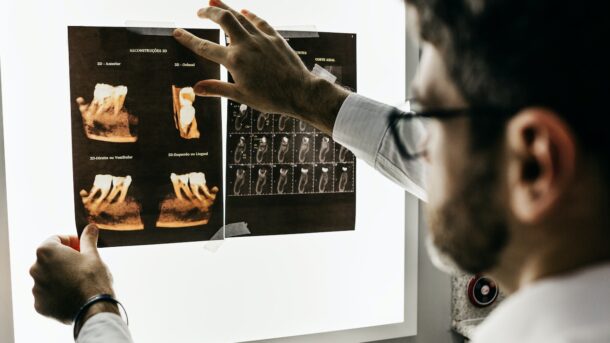In a healthcare setting, evaluating and treating a person as a whole while addressing
individual concerns is the way it should always be. Sadly, even in today’s world, that is not
always the case. Traditional medicine often will compartmentalize each organ and bodily system,
treating one specific concern at a time without considering how the rest of the body will be
affected. This addresses the well-being of specific areas in a more one-dimensional way. The
body is a beautifully complex orchestra of systems performing in their unique roles and coming
together as one functioning human. Learning how these systems interact and considering each
aspect of a human’s mind, body and lifestyle is key to embracing decisions that maintain health.
Functional medicine looks at the overall picture of a person. Realizing that one area of the body
may be affecting another, as well as the consequences of the environment, lifestyle factors, sleep, nutrition, and stress.
Specifically, functional dentistry has become its own category in the realm of this root
cause approach to healthcare. Many times, the mouth is looked at as a separate entity, something that has little to no effect on the rest of the body. Science shows us that a person’s oral health has a systemic effect. Teeth are directly connected to the brain through nerves, and the mouth has a bounty of vascularities connecting it directly to the bloodstream. Functional dentists focus on not just having healthy teeth and gums but the extension of how this contributes to the body, mind, and life experience. Instilling a connection between a primary doctor and a dentist would be extremely beneficial for societal health and, in the long run, be much more cost-effective.
The main goal of functional dentistry is to treat a person in more of a full-scale sense,
looking at all factors and working toward discovering the root cause of a condition or concern. A
dentist that makes it a priority to explain how your oral health connects to your overall health is
not only more beneficial but makes the most sense for the patient’s health long-term. The routine
of brushing, flossing, and getting dental checkups is great but hasn’t been enough.
According to a report commissioned by the EFP and published by the Economist, “the
prevalence of periodontitis has remained largely unchanged over the last 10 years.” This is based
on data in European countries. The United States also suffers from high rates of periodontal
disease and cavities. It was stated by the CDC that “47.2% of adults (in the USA) aged 30 years and older have some form of periodontal disease. Periodontal disease increases with age, 70.1%
of adults 65 years and older have periodontal disease.” In a 2016 study, it was found that “over
90% of adults in the United States have had a cavity. They also reported that 1 in 4 adults have
cavities that are untreated.”
Periodontal disease and cavities are global health issues. They are also completely preventable and treatable. Gingivitis, or bleeding gums, is the precursor to periodontal disease. It is reversible but once gingivitis advances to periodontal disease it becomes irreversible and must be controlled to prevent tooth loss. When gingivitis becomes periodontal disease, the alveolar bone supporting the teeth breaks down and diminishes. Without alveolar bone, there is less support for the teeth and they become loose.
With patient education and effective follow-through, gingivitis can be reversed and periodontal disease prevented. Preventing periodontal disease can help to prevent systemic health issues like diabetes, heart disease, arthritis, fertility concerns, and even Alzheimer’s disease.
Periodontal disease is a huge concern for societal health. As are cavities, tooth pain, oral infections, and other issues concerning the mouth. Many of these issues can be avoided with the promotion of proper patient education. Educating patients to understand the importance of following through with good oral home care habits will increase their willingness to keep their mouths healthy. Functional dentists and dental hygienists have the role of educating patients on the best practices to keep their mouths healthy and disease-free all while supporting their overall health.
Cavities and periodontal disease are the most common oral diseases in the world and contribute to not just health concerns but various economic concerns as well. Some statistics from the CDC show “on average, over 34 million school hours are lost each year because of unplanned (emergency) dental care. Over $45 billion is lost in productivity in the United States each year because of untreated oral disease.” So if patient education is implemented, why are these diseases left untreated, and how does it get to that extent? There is a large group of the population that either avoids the dentist due to fear, cost, or lack of knowledge. Many will not see a dentist until there is a toothache or serious concern. A study done in 2010 stated, “Indirect costs due to dental diseases worldwide amounted to US$144 billion yearly, corresponding to economic losses within the range of the 10 most frequent global causes of death. Within the limitations of currently available data sources and methodologies, these findings suggest that the global economic impact of dental diseases amounted to US$442 billion in 2010. Improvements in population oral health may imply substantial economic benefits not only in terms of reduced treatment costs but also because of fewer productivity losses in the labor market.” Public oral health promotion and policy changes that strive to make dental care more affordable and accessible to underprivileged communities are in great need.
Various industries, i.e. the sugar industry, spend millions of dollars on marketing their products. They make sugary foods and beverages cheap and affordable. It’s been shown that those with lower socioeconomic status have higher rates of cavities and choose more affordable food options. There needs to be greater pressure from the dental industry and policymakers to influence change in the sugar industry’s marketing strategies. One study suggested adding pictorial warnings to sugary foods and beverages, as they now do on tobacco products. The study showed that people bought 17% fewer sugary items when they had pictorial warnings of the increase in heart damage and diabetes on them. These industries knowingly cause poor oral health to vulnerable communities. Public health campaigns that encourage good oral health through innovative ideas such as pictorial warnings should be implemented immediately. Along with the inclusion of oral health discussed at primary doctor appointments. This could save billions of dollars in not only patients’ pockets but also the workplace due to employees needing less time off work needed for dental care and other health issues.
Dental interventions should be promoted at an early age to prevent periodontitis later on in life. Recent studies have shown promising effects of early intervention relating to cost-effectiveness. A European study stated, “The role of home care by patients is paramount to preventing gingivitis and periodontitis. Our economic analysis shows that both eliminating gingivitis (the precursor to periodontitis) using home care prevention techniques (such as tooth brushing and interdental brushing) and increasing the diagnosis rate of periodontitis to 90% with all patients diagnosed being managed have a positive return on investment in all the European countries in this study.” By implementing these early prevention strategies, the results could be the same for the United States. By reversing gingivitis with routine proper home care and education from dentists and dental hygienists, periodontitis can be prevented. The same goes for educating patients on methods to prevent dental cavities.
A complete health assessment is needed to give the best advice for each person. For example, knowing all of a patient’s medical conditions, medications, and health history are crucial to preventing dental decay and periodontal disease. Patients may leave out critical information regarding their overall health when completing a medical history form given to them at dental offices. Many still do not understand the connection and why dental professionals need to know everything regarding their comprehensive health. There is a plethora of evidence linking oral health and overall health. Integrating this connection is still developing, but simply merging health information from a patient’s primary care provider and dental provider would be a great way to easily join the two. Then, information isn’t left out, and dental professionals can understand the whole picture of a person’s health. Dental decay and periodontal disease can originate from various components, and it’s pivotal for dentists and dental hygienists to understand the full scope of a patient’s health to help them to create the best possible plan of action to prevent oral disease and thus create cost-effectiveness throughout their patient base. This is the basis of functional dentistry. Treating the patient not only based on their oral conditions but also considering the rest of their health and life choices.
Oral diseases are just one aspect of functional dentistry. Sleep-disordered breathing, stress management, oral microbiome education, and dietary recommendations are emphasized in a functional dentistry setting. Addressing the root cause increases the prevention of disease and helps people understand the role that oral health has on their bodies. Great health cannot occur without great oral health. Systemic diseases like diabetes and heart disease are linked to the mouth. Having an understanding of a patient’s total health will help dental professionals take a whole-body approach to treating them.
Connecting primary care and dental care would create a multifaceted approach to a patient’s healthcare experience. Public health prevention strategies and policy changes geared towards creating awareness of the connection between oral health and overall health will create positive change and save costs in the long run.
References
Bouchard, Philippe, et al. “Time to Take Gum Disease Seriously – Impact.economist.com.” The Economist Intelligence Unit, 2021,
impact.economist.com/perspectives/sites/default/files/eiu-efp-oralb-gum-disease.pdf.
Bui, Fiona Q., et al. “Association between Periodontal Pathogens and Systemic Disease.” Biomedical Journal, Elsevier, 2 Mar. 2019,
www.sciencedirect.com/science/article/pii/S2319417018302634.
Division of Oral Health. “Cavities.” Centers for Disease Control and Prevention, Centers for Disease Control and Prevention, 25 Jan. 2021,
www.cdc.gov/oralhealth/fast-facts/cavities/index.html.
Division of Oral Health. “Periodontal Disease.” Centers for Disease Control and Prevention, Centers for Disease Control and Prevention, 10 July 2013,
www.cdc.gov/oralhealth/conditions/periodontal-disease.html.
Listl, S., et al. “Global Economic Impact of Dental Diseases.” Journal of Dental Research, vol. 94, no. 10, Oct. 2015, pp. 1355–1361, doi:10.1177/0022034515602879.
The post The Link Between Oral Health and Overall Health: A Public Health and Economic Concern appeared first on Ask the Dentist.







